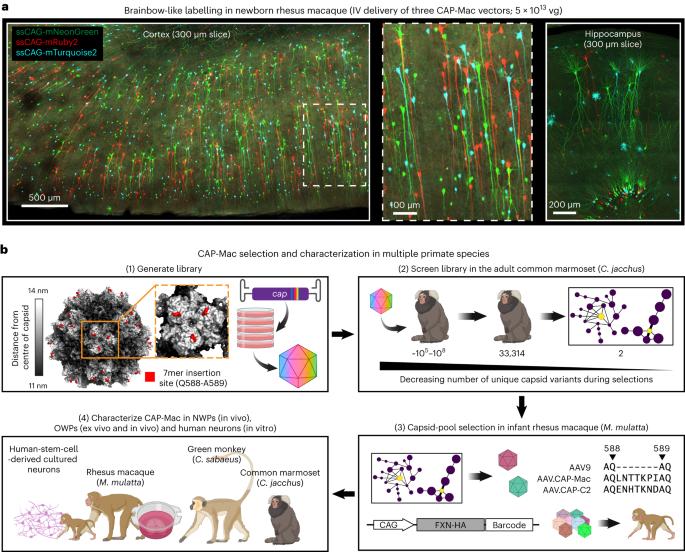腺相关病毒载体用于在整个非人灵长类动物大脑中进行功能性静脉内基因转移。
IF 38.1
1区 材料科学
Q1 MATERIALS SCIENCE, MULTIDISCIPLINARY
引用次数: 0
摘要
在灵长类动物中,跨越血脑屏障是基因传递到大脑的主要障碍。腺相关病毒(AAVs)有望将强大的、非侵入性的基因从血液输送到大脑。然而,与啮齿类动物不同的是,在非人类灵长类动物中,很少有嗜神经性AAV能有效地穿过血脑屏障。在这里,我们报道了AAV.CAP-Mac,这是一种通过在成年狨猴和新生猕猴中筛选确定的工程变体,它提高了多种非人类灵长类动物(狨猴、恒河猴和绿猴)大脑中的递送效率。CAP Mac在东半球幼年灵长类动物中是神经元偏向性的,在成年恒河猴中表现出广泛的向性,在成年狨猴中是血管系统偏向性的。我们展示了单次静脉注射剂量的CAP Mac的应用,以在多个大脑区域提供功能性GCaMP用于离体钙成像,或在整个猕猴大脑中提供Brainbow样标记的荧光报告子混合物,从而避免了旧世界灵长类动物对种系操作的需要。因此,CAP Mac被证明具有在非人类灵长类动物大脑中进行非侵入性系统性基因转移的潜力。本文章由计算机程序翻译,如有差异,请以英文原文为准。

Adeno-associated viral vectors for functional intravenous gene transfer throughout the non-human primate brain
Crossing the blood–brain barrier in primates is a major obstacle for gene delivery to the brain. Adeno-associated viruses (AAVs) promise robust, non-invasive gene delivery from the bloodstream to the brain. However, unlike in rodents, few neurotropic AAVs efficiently cross the blood–brain barrier in non-human primates. Here we report on AAV.CAP-Mac, an engineered variant identified by screening in adult marmosets and newborn macaques, which has improved delivery efficiency in the brains of multiple non-human primate species: marmoset, rhesus macaque and green monkey. CAP-Mac is neuron biased in infant Old World primates, exhibits broad tropism in adult rhesus macaques and is vasculature biased in adult marmosets. We demonstrate applications of a single, intravenous dose of CAP-Mac to deliver functional GCaMP for ex vivo calcium imaging across multiple brain areas, or a cocktail of fluorescent reporters for Brainbow-like labelling throughout the macaque brain, circumventing the need for germline manipulations in Old World primates. As such, CAP-Mac is shown to have potential for non-invasive systemic gene transfer in the brains of non-human primates. Crossing the blood–brain barrier in primates is a major obstacle to gene delivery in the brain. Here an adeno-associated virus variant (AAV.CAP-Mac) is identified and demonstrated for crossing the blood–brain barrier and delivering gene sequences to the brain of different non-human primates species.
求助全文
通过发布文献求助,成功后即可免费获取论文全文。
去求助
来源期刊

Nature nanotechnology
工程技术-材料科学:综合
CiteScore
59.70
自引率
0.80%
发文量
196
审稿时长
4-8 weeks
期刊介绍:
Nature Nanotechnology is a prestigious journal that publishes high-quality papers in various areas of nanoscience and nanotechnology. The journal focuses on the design, characterization, and production of structures, devices, and systems that manipulate and control materials at atomic, molecular, and macromolecular scales. It encompasses both bottom-up and top-down approaches, as well as their combinations.
Furthermore, Nature Nanotechnology fosters the exchange of ideas among researchers from diverse disciplines such as chemistry, physics, material science, biomedical research, engineering, and more. It promotes collaboration at the forefront of this multidisciplinary field. The journal covers a wide range of topics, from fundamental research in physics, chemistry, and biology, including computational work and simulations, to the development of innovative devices and technologies for various industrial sectors such as information technology, medicine, manufacturing, high-performance materials, energy, and environmental technologies. It includes coverage of organic, inorganic, and hybrid materials.
 求助内容:
求助内容: 应助结果提醒方式:
应助结果提醒方式:


